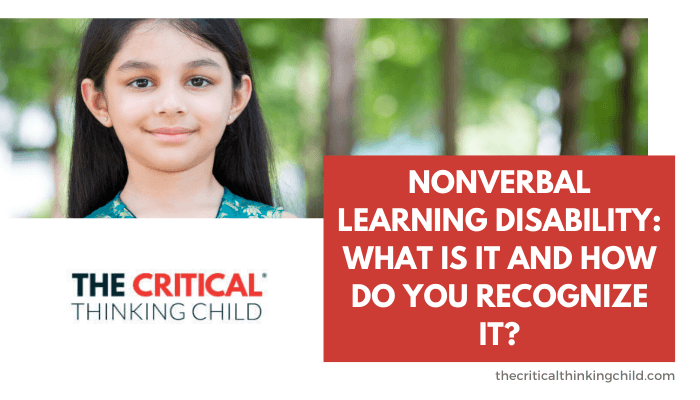Spatial learning is a foundational skill that’s important for all children to learn. In fact, it’s one of the SMART Skills we focus on here at The Critical Thinking Child, and a number of our resources focus on spatial learning.
But what happens when your child struggles with these skills?
“Most parents recognize that a child who isn’t talking by age two should be evaluated for a learning disorder. But no one thinks twice about kids who have problems with visual-spatial tasks,” says Amy E. Margolis, PhD, assistant professor of medical psychology at Columbia University Vagelos College of Physicians and Surgeons. Very few parents have heard of Nonverbal Learning Disabilities, or NVLDs. Today we’ll cover the basics: what it is, how to recognize it in your child, and what to do about it if your child is diagnosed.
What is a Nonverbal Learning Disability?
NVLDs are neurodevelopmental learning disorders that may affect up to 3 million children in the U.S. alone, making it one of the most common (and least talked about!) learning disorders. Despite the name, children with NVLDs are verbal and don’t tend to have trouble reading or speaking. Instead, they have difficulties with visual-spatial skills.
Instead of reading, these difficulties affect math, fine motor, and social skills. According to the Child Mind Institute, NVLD difficulties can be broken down into five categories:
- Visual and spatial awareness: This involves a solid understanding of objects and where they are in space.
- Higher-order comprehension: How easily can your child identify the main idea of a story or lesson? What about supporting details? This is higher-order comprehension and children with a NVLD can struggle with it.
- Social communication: It’s not always easy to know how another person is feeling, and this is even more true for some people with an NVLD. From reading emotion in expressions to understanding tone of voice, this can be a struggle.
- Math concepts: Going back to higher-order comprehension, this difficulty shows up when math extends beyond rote memorization. Problem solving (especially word problems that require some amount of visualization) may prove difficult.
- Executive functions: How well can your child plan and organize? This can sometimes strike those with NVLDs as hard, because it requires chunking big ideas down into smaller pieces.
How do you recognize a NVLD?
At home, be on the lookout for struggles with Legos or jigsaw puzzles, since those are particularly challenging for children with NVLDs. Your child might also have trouble with fine motor activities like tying their shoes or cutting with scissors.
When you’re out and about, pay attention to how your child interacts with their siblings or peers. Take time to notice how they respond to social cues, conceptualize ideas, and plan for the future.
While difficulty in any one of these areas isn’t a sure sign of an NVLD, it’s worth mentioning to your child’s pediatrician. They might refer you to the psychological testing group at your child’s school, who can test your child at no cost and give you more information about areas of need.
According to EurekAlert, a nonverbal learning disorder diagnosis a child must have a deficit in spatial reasoning as well as impairment in two of the following four domains: fine motor skills, math calculation, visual executive functioning, and social skills.
What do you do if your child is diagnosed with a NVLD?
Fortunately, there are a number of resources available to students with nonverbal learning disorders. If your child is diagnosed, take a look at our resources for supporting critical thinking with paper-folding puzzles and math patterns.
In the Paper-Folding Puzzles book, parents and educators can use these child-friendly puzzles to promote cognitive thinking skills in the classroom or at home. The workbook has over 100 practice questions, designed for the STEM/STEAM-focused children ages 6-12, that increase in complexity. This puzzle book has also been enjoyed by high school and college students. Questions are presented in a reading-free or non-verbal format where reliance on the knowledge of spoken English is unnecessary.
Inside the Critical Thinking with Math Patterns, Codes and Problem Solving book are puzzles, patterns and out of the box child-friendly exercises and questions that promote STEM activities including number sense, math reasoning, problem solving, spatial thinking, logical reasoning and critical thinking skills in the classroom or at home.
This book includes a series of fun, engaging and challenging academic questions on arithmetic, geometry and measurements, patterns and algebraic thinking. The workbook has over 300 practice questions, for young mathematical minds in first and second grade (ages 6-8).
Both of these books provide fun opportunities for your child to practice their spatial skills in a low-pressure environment.
Although your child may be wary of it, encourage work on jigsaw puzzles and Legos. Making it a family activity can reduce stress and help your child get much-needed practice. Similarly, don’t just tie your child’s shoes for them. Although it may be a frustrating process for everyone involved, helping your child learn to do these things independently will ultimately empower them.
Don’t despair if you notice your child’s difficulties with spatial tasks. Know the signs, talk to your child’s pediatrician, and try some of our resources to improve spatial thinking at home!
Sources used:
Child Mind, “What is a Nonverbal Learning Disorder”
EurekAlert, “Visual-spatial learning disorder is more common than thought, finds study”



